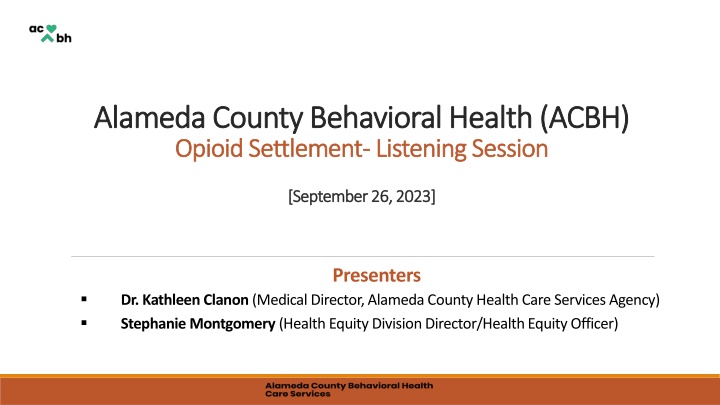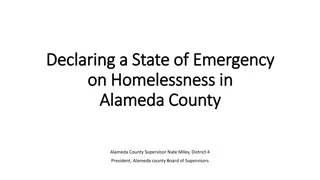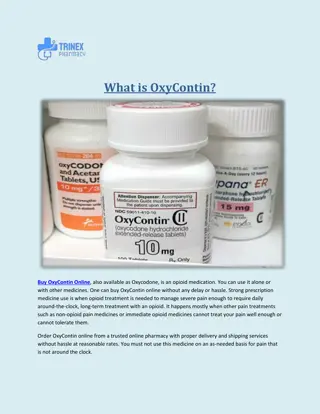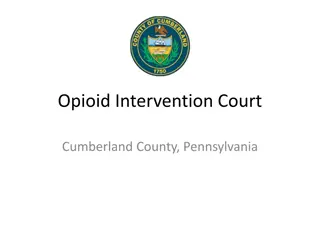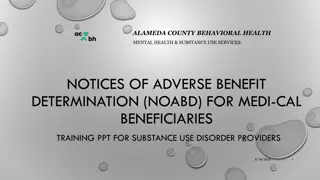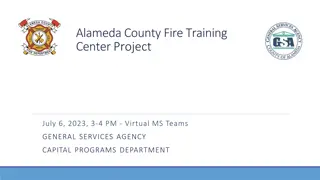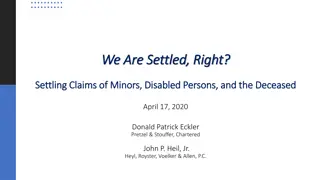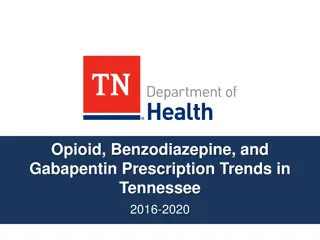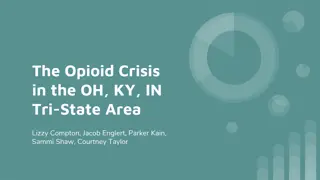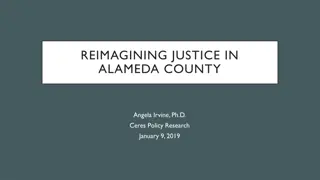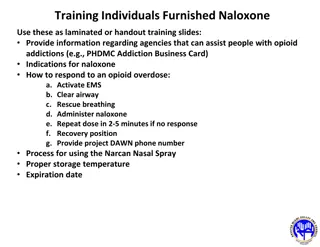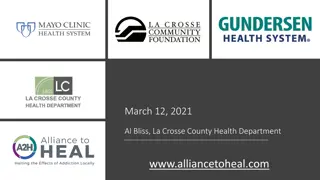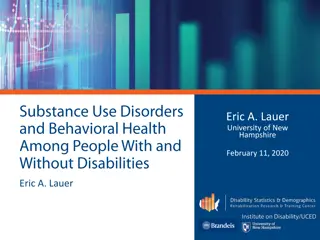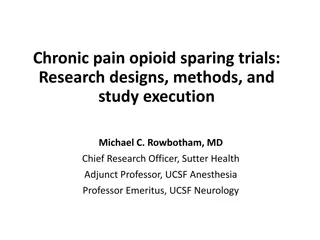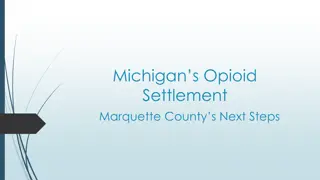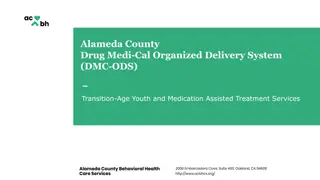Alameda County Behavioral Health Opioid Settlement Listening Session
Alameda County Behavioral Health (ACBH) conducted a listening session on September 26, 2023, addressing the opioid crisis, definitions of opioids, medication-assisted treatments, and current data on overdose deaths in the county. The session highlighted the rapid increase in opioid-related overdose deaths and the need for effective interventions to combat this public health issue.
Download Presentation

Please find below an Image/Link to download the presentation.
The content on the website is provided AS IS for your information and personal use only. It may not be sold, licensed, or shared on other websites without obtaining consent from the author.If you encounter any issues during the download, it is possible that the publisher has removed the file from their server.
You are allowed to download the files provided on this website for personal or commercial use, subject to the condition that they are used lawfully. All files are the property of their respective owners.
The content on the website is provided AS IS for your information and personal use only. It may not be sold, licensed, or shared on other websites without obtaining consent from the author.
E N D
Presentation Transcript
Alameda County Behavioral Health (ACBH) Alameda County Behavioral Health (ACBH) Opioid Settlement Opioid Settlement- - Listening Session Listening Session [September 26, 2023] [September 26, 2023] Presenters Dr. Kathleen Clanon (Medical Director, Alameda County Health Care Services Agency) Stephanie Montgomery (Health Equity Division Director/Health Equity Officer)
Definition: Opioid Definition: Opioid Opioids are a broad class of drugs, natural and man-made, that act on body and brain to reduce the signals and feelings of pain. At higher doses, they can also cause sleep and can cause people to stop breathing. Norco OxyContin Morphine Methadone Fentanyl Oxycodone Tramadol Carfentanyl Percocet Hydrocodone Vicodin Oxymorphone Codeine Dilaudid Hydromorphone Heroin
Medication Medication- -assisted treatment (MAT) assisted treatment (MAT) MAT, sometimes referred to as Medication for Addiction Treatment, is a treatment for opioid use disorder combining the use of medications such as methadone and buprenorphine (AKA Suboxone) with counseling and behavioral treatments. MAT is used to decrease withdrawal symptoms and cravings, to reduce the chances of relapse, and help people stay in a treatment program. If relapse does happen, people on buprenorphine MAT have lower rates of fatal overdose because their body is still used to having opioids on board.
Current Data Current Data 4 5/10/2024
All overdose deaths are increasing All overdose deaths are increasing driven by opioids driven by opioids Overdose deaths are increasing each year. Opioid deaths are increasing as a proportion of overall overdoses. Polydrug overdoses that include opioids and stimulants are the fastest growing segment. 6 5/10/2024
Rapid increase in overdose deaths starting in 2017 Rapid increase in overdose deaths starting in 2017 Drug Overdose Deaths by Year Alameda County Residents 2005-2021 Age-Adjusted Rate per 100,000 25 Drug Poisoning 20 Any Opioid Population 15 10 5 0 2005 2006 2007 2008 2009 2010 2011 2012 2013 2014 2015 2016 2017 2018 2019 2020 2021 Notes: (1) Deaths of Alameda County residents, no matter where they occurred. (2) An overdose is a fatal poisoning. 7 5/10/2024
Opioid Poisoning deaths higher among Men Opioid Poisoning deaths higher among Men Drug Overdose Deaths by Gender 2019-2021 Age-Adjusted Rate per 100,000 28.1 30 Any Opioid Drug Poisoning 25 Population 18.3 20 15.4 15 9.4 8.8 10 3.5 5 0 Total Male Female Source: ACPHD CAPE, with data from VRBIS. 8 5/10/2024
Opioid Poisoning deaths affect adults of all ages Opioid Poisoning deaths affect adults of all ages Drug Overdose Deaths by Age Group 2019-2021 Age-Adjusted Rate per 100,000 35 32.2 Any Opioid Drug Poisoning 30.9 28.1 30 27.9 Population 25 20 17.7 17.2 15.0 13.9 13.4 15 11.4 10 7.0 6.9 5 0 15-24 25-34 35-44 45-54 55-64 65-74 Source: ACPHD CAPE, with data from VRBIS. 9 5/10/2024
Overdose deaths disproportionately high among Black residents Overdose deaths disproportionately high among Black residents Overdose Deaths by Race/Ethnicity 2019-2021 Age-Adjusted Mortality Rate per 100,000 60 55.3 Any Opioid Any Drug 50 40 Population 27.4 30 22.4 19.2 18.3 18.0 20 11.3 11.0 9.4 9.1 10 0 All Races African American/ Black White Hispanic/Latino All Other Races Notes: (1) All other races includes Asian, Native American, Pacific Islander, and Multi-race. (2) Deaths of Alameda County residents, no matter where they occurred. Source: ACPHD CAPE, with data from VRBIS, CA s Vital Records Business Information System. 10 5/10/2024
Opioid Opioid- -related ER visits also disproportionately high among related ER visits also disproportionately high among Black residents Black residents Non-Fatal Opioid-Related Hospitalizations and ED Visits 2019-2020 All Races 341.2 African American/Black 1,311.6 White 386.8 Multirace 374.0 Native American 365.8 Hispanic/Latino 262.0 Pacific Islander 113.1 Asian 21.3 0 200 400 600 800 1,000 1,200 1,400 Age-Adjusted Rate per 100,000 Population Notes: (1) The race/ethnicity coding changed in 2019, so the data shown for race/ethnicity span only two years. (2) Hospital visits of Alameda County residents, no matter where they occurred. Source: ACPHD CAPE, with data from HCAI. 11 5/10/2024
Opioids driving overdose deaths among PEH Opioids driving overdose deaths among PEH Overdose deaths are increasing each year with People Experiencing homelessness (PEH) accounting for about 30% of all overdose deaths. Polydrug overdoses including opiates have sharply increased between 2020 and 2021. 12 5/10/2024
Conclusions from the data Conclusions from the data Opioid poisoning deaths in Alameda County are continuing to rise Opioids alone and in combination are driving that increase. Overdose deaths disproportionately impact African Americans, men, and people experiencing homelessness. People experiencing homelessness account for about 30% of all overdose deaths. 13 5/10/2024
Overview of Approach Overview of Approach 14 5/10/2024
Evidence Evidence- -based interventions to reduce based interventions to reduce opioid overdose deaths opioid overdose deaths Targeted Naloxone distribution e.g., transitional housing, treatment centers, and in criminal justice settings Medication-Assisted Treatment (MAT) Healthcare provider education on screening for and diagnosing Substance Use Disorder and connecting people to treatment. Eliminating insurance barriers for medications for opioid use disorder Screening for fentanyl in routine lab tests 911 Good Samaritan laws MAT in criminal justice settings and on release Starting suboxone/buprenorphine-based MAT in Emergency Departments Syringe services programs
Opioid Overdose Intervention Points TREAT OPIOID ADDICTION REDUCE OPIOID EXPOSURE Public education Collect unwanted meds Stigma reduction RESCUE Naloxone use training Naloxone distribution Recovery Housing Detox facilities Long-acting injectable MAT Medication Assisted Treatment (MAT) Harm Reduction Supply Treatment Exposure Rescue REDUCE HARM Drug checking Supervised use Test strips Syringe Service Programs REDUCE OPIOID SUPPLY Public protection partners Prescriber education Prescriber accountability 16 5/10/2024
Opioid Litigation Settlement Update Opioid Litigation Settlement Update 17 5/10/2024
Key National Settlement Terms Key National Settlement Terms More than 3,000 state and local governments have targeted opioid makers and distributors in hopes of recouping billions in tax dollars spent dealing with the opioid epidemic [Opioids - National Association of Attorneys General (naag.org)]. In 2018, the County of Alameda and several cities also decided to join. In 2021 and late 2022 nationwide settlements were reached to resolve all opioid litigation against the three largest pharmaceutical distributors, a major producer, and three pharmacy chains. Funds will be paid overtime, from 6 to 18 years, depending on the settlement. At least 85% of the funds must be used for opioid abatement, for the County almost all funds being received are restricted to funding future abatement efforts. 18 5/10/2024
CA Opioid Abatement Priority Areas CA Opioid Abatement Priority Areas 1) Creating new or expanded Substance Use Disorder (SUD) treatment infrastructure. 2) Matching existing funds for SUD within the Behavioral Health Continuum Infrastructure 3) Addressing the needs of communities of color and vulnerable populations (including sheltered and unsheltered homeless populations) that are disproportionately impacted by SUD. 4) Diversion of people with SUD from the justice system into treatment, including by providing training and resources to first and early responders and implementing best practices for outreach, diversion and deflection, employability, restorative justice, and harm reduction. 5) Interventions to prevent drug addiction in vulnerable youth. 19 5/10/2024
ACBH Opioid Settlement Program Planning ACBH Opioid Settlement Program Planning 20 5/10/2024
Goals Goals Expenditure of Opioid Settlement funds to address opioid crises in Alameda County. Expand and enhance Substance Use System of Care with targeted investment from the opioid settlement. Periodic Stakeholder process to inform, educate and update on ACBH s settlement funding planning and to receive community feedback and input. Expend settlement funding on prevention efforts such as public media campaign to address opioid misuse and to educate on Substance Use Services in Alameda County. 21 5/10/2024
Opioid Settlement Planning An Integrated Approach 22 5/10/2024
Process Process Communities Most Impacted Stakeholder Process People Experiencing Homelessness; Chronic Substance-Dependent individuals; Periodic Public Updates Overtime Incarcerated; and Black/African American 23 5/10/2024
Opioid Settlement Planning Opioid Settlement Planning Planning, Location/ Districts System, Program, CBO, and Agency Integration Community Input BOS Long-Term Sustainability Implementation Priorities 24 5/10/2024
ACBH Plans for Opioid Settlement Dollars Public media campaign regarding the opioid crisis Fund more Medication Assisted Treatment (MAT) services. Establish hospital based medical detoxification beds. Mini grants to community organizations to address opioid crisis. 25 5/10/2024
Social Social Determinants Determinants of Health of Health Our own data clearly indicates that African American males are disproportionately represented compared to other demographics. 5/10/2024 Understanding SDOH can support strategies that will support and pave the way for better outcomes for those most impacted within our system of care. 26
Education Social & Community Context Race Social Determinants of Health Neighborhood & Built Environment Gender Health Care System Social Support 27 5/10/2024
Health Equity It's important to acknowledge how institutional and structural racism affect the care and support of individuals most affected by opioid use. We need to actively strive to break down these barriers and develop a new, culturally sensitive approach to care that is inclusive and supportive for those who need it. Image Credit: A collaboration between Center for Story-based Strategy & Interaction Institute for Social Change. 28 5/10/2024
29 5/10/2024
Community Input & Feedback This Photo by Unknown Author is licensed under CC BY-NC-ND 30
31 5/10/2024
